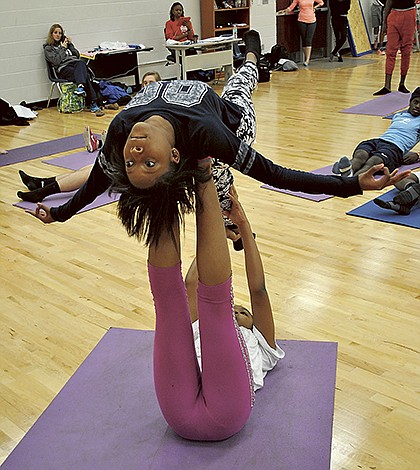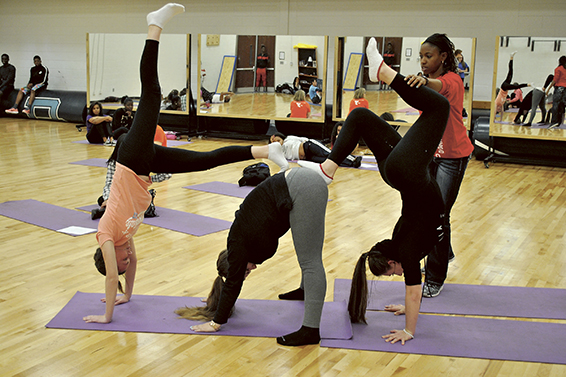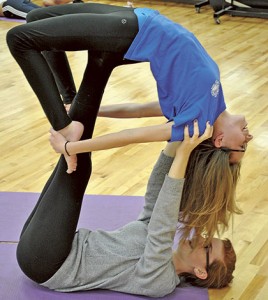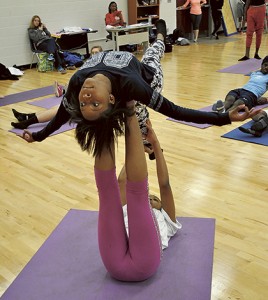- July 26, 2024
-
-
Loading

Loading


DR. PHILLIPS — With thousands of students at Dr. Phillips High School, only so many will find dodgeball, laps around the track and tossing footballs as attractive an option for physical education credits.
This is one reason Moushaumi Robinson, an instructor at the school and head coach of the school’s girls’ weightlifting team, has been offering dance kinesiology and somatics courses for four years, now over six periods at two levels.
“It’s a yoga and Pilates stress management and relaxation class where we do different things,” Robinson said. “On Mondays, we usually do yoga, but I just kept with this series because everyone took to it, so I wanted to just push through it. Tuesdays are usually our Pilates days and core days."
Wednesdays involve stress management, including a stress management guide her classes are making; Thursdays are for mild kinetics, mentally focusing on a muscle area to trigger more work in the area; and Fridays are usually relaxation days, with visualization and meditation, Robinson said.
But Friday, Feb. 6, was the day students demonstrated partner poses for a test, in which each pair had to hold a pose for 20 seconds. Students contorted their bodies together in various artistic positions to show strength, balance and flexibility.
“They’ve been doing this for two weeks, trying all kinds of things; some of them give me heart attacks,” Robinson said. “This is the first year we’re opening up to partner yoga, because the kids did so well advancing through Pilates and the basic things. It was really them that started doing the more difficult poses, so…they pushed their limits, and their parents know that: at the beginning of the year, they get a syllabus so they know it’s a hands-on class; they’re going to have to share and be acclimated to each other’s space. The staff will comment that they want to come try it.”

THE COURSE
Robinson’s classes have about 45 students each, so she teaches around 250 per day, she said, leading them in stretching, core, spine-lengthening, breathing techniques and mental health exercises alleviating stress, frustration or anger.
“The course was originally created by Kathy Follensbee,” Robinson said. “She’s with dance here, and she taught it one period, and I came and taught it all periods — it’s the only course I teach. It was really set up to be a performing arts credit, for those kids that didn’t want to dance but…a movement type of class that wasn’t weightlifting, because our electives are team-sports related. A lot of girls didn’t want to do that, and guys didn’t want the dance elective, so it was a blend between that to give them an entirely different option.”
This different option and the newness of yoga and Pilates excites students, who do more than regular gym classes, which need a health component, she said.
“My class, we’re in here every day doing the exercises,” she said. “It renders them more physical activity. I think that when kids see their teachers being active — that I do what they actually do — it encourages them. Especially the boys think if I can do it, they can do it — I can’t be stronger than them. I might be — actually, I am — but try it. Then they see what they can do.”
Participation among boys is increasing, now around 25% of Robinson’s students, especially athletes, she said. Each course is a mix of all grades and cultures, too.
“I think that’s the best part of the class: they get ninth-12th all together in this kind of elective with this many kids, to see a lot of different things,” she said. “I grade them on themselves, not with the class. I grade their effort — everyone can’t do everything. They should definitely see themselves improve.”
Robinson’s students are also graded to have fun, care for their bodies and improve mental health, but partner poses are the best lesson they have performed, she said.
“I thought they’d be apprehensive, but they dove right in,” she said. “They’re using their phones to Google poses asking to try this or that.”
Sometimes Robinson has to tell them a pose is too hard; sometimes, she allows it but with double mats.

THE CIRCLE
“Sometimes we do what I call the circle, where we’ll get in a circle and we’ll talk about…what they’ve been stressed about, depending on what type of Friday it is,” Robinson said. “I’ll ask them what they want to do; they usually choose to talk, and if they’re tired, they’ll choose to sleep.”
Although teens have a reputation of craving sleep and avoiding personal discussions, Robinson’s classes enjoy these no-limits talks.
“They’ve all signed, saying they’ll keep things confidential, and understand there are repercussions if anything was shared,” Robinson said. “It’s interesting as an adult to watch young people relate through whatever they have going on. One of the biggest ones is divorce. When kids start talking about that and see how many other kids’ parents are divorced, they start advising each other. It’s really cool to watch the peer group get together and dialogue with kids they probably wouldn’t have looked at twice, just walking around such a large campus. I enjoy their learning on their own, without me having to connect them.”
Robinson starts each year doing most of the talking, starting with generic questions before students become comfortable opening up. She even incorporates current events, such as the State of the Union, to get their perspectives and foster discussions about important issues in their lives.
“So many different topics come up, but the number one is always relationships,” Robinson said. “They’re very mature. For them to be able to articulate and encourage each other…that’s not something I have to say as an adult — it’s other young people. It causes the students in this class to have a different relationship with each other…you have to be connected internally with someone. It’s more cognitive…being able to show empathy and step outside of yourself. It’s a lot of unselfishness…to make this class work. They become honorable of what this class is supposed to be and respect the space, each other and authority.”
Robinson finds fulfillment seeing students push themselves every day, crossing common lines and mental barriers of high school, she said.
“I had an evaluation; one of the administrators came in and said she noticed they automatically spot each other, and it doesn’t matter what group of friends they’re with,” Robinson said. “You have a hard time telling someone to…get out the hallway, let alone jump to aid a group of peers. The beautiful part is it is more than just teaching yoga. It is really teaching them life skills, adaptation in their environment and doing what I ask them to do. You can’t teach kids to come out of their shell or relate to different peers. Those are things they have to understand and immerse themselves in, and I think this class facilitates that: hands on, encouraging each other, just getting in there no matter what. I see growth throughout the year that may not be shown on a sheet of paper.”
THE POSSIBILITIES
Donna Davis, a health teacher at Edgewater High School, helped Robinson write End of Course tests for her advanced course and has been teaching it at Edgewater.
With EOCs available, Robinson hopes more schools will offer this course to get children active in a different way, to the point some need two teachers for it.
“I definitely would love to see it in all Orange County high schools as…a different option,” she said. “The dynamics of the class just lends itself to peers getting to know each other better.”
Instructors have freedom to tailor the class to their needs, and it offers learning qualities lecture courses cannot, as well as classroom management, space alignment, group teaching, peer-to-peer evaluation, change and student maturation, she said.
“It has inspired students to learn about exercises and (health) they might never otherwise have (sought),” she said. “We’re really trying to figure out how it could be a PE credit of some kind. The only issue with that is the health component. If they didn’t have to have the health component and there was a way they could…do it separate, that’d be great — have health one semester. The kids love it. They get a performing arts credit. It’s an elective; they don’t care — they’ll come and try anything.”
Robinson’s philosophy of maximizing and diversifying activities inspiring children to exercise can change lives.
“We’re getting into a health and fitness era,” she said. “Teaching our kids young with childhood obesity, you can’t miss.”
Contact Zak Kerr at [email protected].